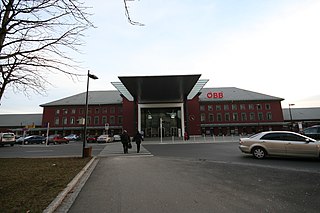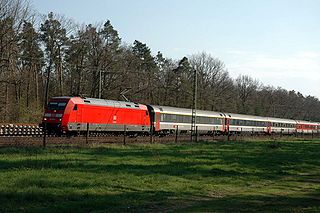 | |
| Overview | |
|---|---|
| Service type | EuroCity (EC) |
| Status | Operational |
| Locale | Austria Czech Republic Poland |
| First service | 1997 |
| Current operator(s) | PKP, ČD, ÖBB |
| Route | |
| Start | Wien Westbahnhof / Villach Hbf |
| End | Warszawa Wschodnia |
| Distance travelled | 991 km (616 mi) |
| Average journey time | 12 h 16 min |
| Service frequency | Daily |
| Train number(s) | EC 102/103 (Austria, Czech republic) EIC 102/103 (Poland) |
| On-board services | |
| Class(es) | first and second class |
| Seating arrangements | open and 6-seat compartments |
| Catering facilities | dining car |
| Technical | |
| Track gauge | 1,435 mm (4 ft 8 1⁄2 in) |
| Operating speed | 160 km/h |
The Polonia is a EuroCity (EC) express train. It was introduced in 1997, to supplement the existing EuroCity train, the Sobieski , on the international route between Vienna, the capital of Austria, and Warsaw, the capital of Poland, via the Czech Republic.

EuroCity, abbreviated as EC, is a cross-border train category within the European inter-city rail network. In contrast to trains allocated to the lower-level "IC" (InterCity) category, EC trains are international services that meet 20 criteria covering comfort, speed, food service, and cleanliness. Each EC train is operated by more than one European Union or Swiss rail company, under a multilateral co-operative arrangement, and all EC trains link important European cities with each other.

Express trains are a form of rail service. Express trains make only a small number of stops, instead of stopping locally. In some cases, trains run express where there is overlapping local train service available, and run local at the tail ends of the line, where there is no supplemental local service. During overnight hours, or other times where it is practical, express trains may become local, but still running to where an express train would terminate.

The Sobieski is a EuroCity (EC) international express train. Introduced in 1994, it runs between Vienna, the capital of Austria, and Warsaw, the capital of Poland, via the Czech Republic.
Contents
The train's name, Polonia , is the Latin word for "Poland".

Poland, officially the Republic of Poland, is a country located in Central Europe. It is divided into 16 administrative subdivisions, covering an area of 312,696 square kilometres (120,733 sq mi), and has a largely temperate seasonal climate. With a population of approximately 38.5 million people, Poland is the sixth most populous member state of the European Union. Poland's capital and largest metropolis is Warsaw. Other major cities include Kraków, Łódź, Wrocław, Poznań, Gdańsk, and Szczecin.

Latin is a classical language belonging to the Italic branch of the Indo-European languages. The Latin alphabet is derived from the Etruscan and Greek alphabets and ultimately from the Phoenician alphabet.
As of 2013 [update] , the northbound train, EC 102, departs from Villach Hbf, in Villach, Austria, at shortly after 09:00, and the southbound train, EC 103, departs from Warszawa Wschodnia in Warsaw at shortly after 06:00. Both trains arrive at their destinations after a journey time, via Vienna, of approximately twelve and a half hours. [1] [2]

Villach Hauptbahnhof is the main railway station in Villach, the second largest city in the Austrian state of Carinthia. It primarily serves as a passenger station and is an important junction within the Austrian Federal Railways (ÖBB) network.

Warszawa Wschodnia is one of the most important railway stations in Warsaw, Poland. Its more official name is Warszawa Wschodnia Osobowa. It is located on the eastern side of the Vistula river, on the border of the Praga Północ and Praga Południe district, on the Warsaw Cross-City Line. It serves a large number of trains as all trains passing through the larger Warszawa Centralna and Śródmieście stations also stop or terminate at Wschodnia station.

















